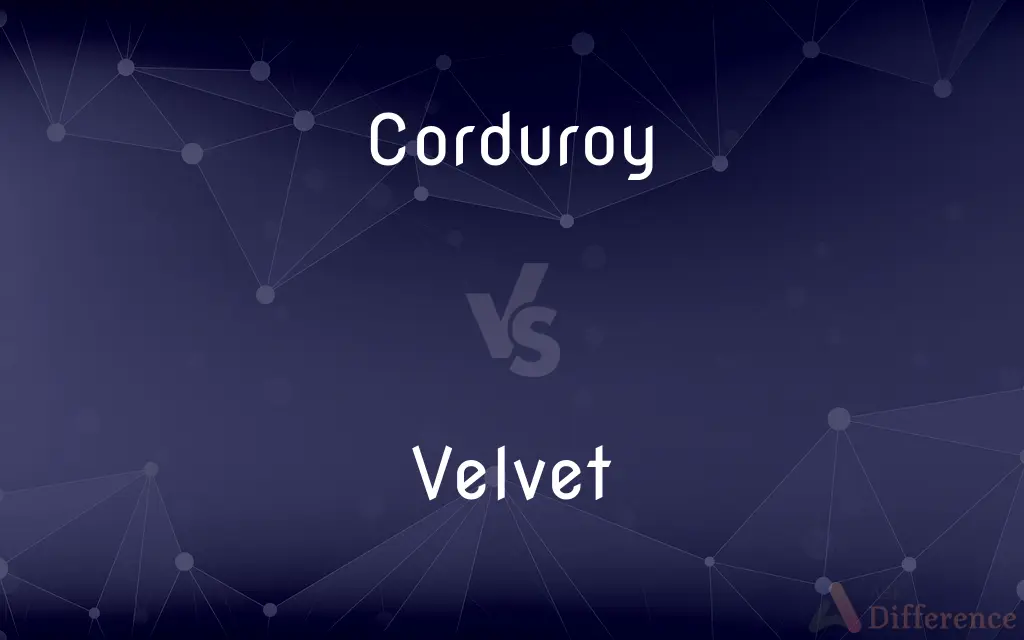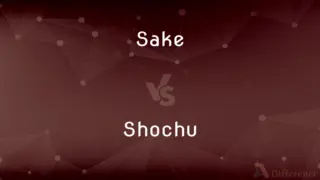Corduroy vs. Velvet — What's the Difference?
By Tayyaba Rehman & Urooj Arif — Updated on April 3, 2024
Corduroy is a durable, ridged fabric known for its distinctive 'wales' or cords, while velvet is a soft, luxurious fabric with a smooth, dense pile.

Difference Between Corduroy and Velvet
Table of Contents
ADVERTISEMENT
Key Differences
Corduroy is characterized by its textured surface, formed by vertical ribs or "wales" that can vary in width. Traditionally made from cotton, it is valued for its durability and warmth, making it popular for clothing such as pants, jackets, and even furnishings. On the other hand, velvet is recognized for its soft, smooth surface with a short, dense pile that gives it a distinctive plush feel. Originally made from silk, velvet is now produced from various fibers, including synthetic ones, to achieve its luxurious texture at different price points.
The production of corduroy involves weaving extra sets of fiber into the base fabric to form the wales, which are then cut to create its textured pattern. Velvet's production, however, entails weaving two thicknesses of the material simultaneously and then cutting them apart, resulting in the fabric's signature soft pile. This technique contributes to velvet's reputation as a more luxurious material, often used in formal wear, upholstery, and curtains.
Corduroy's practicality comes from its strength and ease of care, often being machine washable and resistant to wear and tear. Velvet, while historically associated with nobility and luxury, requires more careful handling to maintain its texture and appearance, including professional cleaning for many types.
The tactile experience of both fabrics is distinctive: corduroy offers a rugged, textured feel, whereas velvet is smooth and soft to the touch. This difference also influences their use in fashion and decor, with corduroy being more casual and rugged, and velvet being chosen for elegance and depth of color.
Both fabrics serve different aesthetics and practical needs in clothing and home décor. Corduroy brings a casual, durable aspect to garments and furnishings, while velvet adds a touch of luxury and sophistication with its soft, opulent texture.
ADVERTISEMENT
Comparison Chart
Texture
Textured with vertical ribs or "wales".
Smooth with a short, dense pile.
Durability
Highly durable and suitable for daily wear.
Delicate, often requiring special care.
Production
Woven with extra fibers to form wales.
Woven from two thicknesses, then cut apart.
Usage
Casual wear, work clothes, furnishings.
Formal wear, luxurious upholstery, curtains.
Care
Generally machine washable.
May require professional cleaning.
Feel
Rugged and textured.
Soft and plush.
Material
Commonly made from cotton.
Originally silk, now available in many fibers.
Compare with Definitions
Corduroy
Made from cotton, used in casual and work apparel.
The corduroy jacket was perfect for fall weather.
Velvet
Used in high-end upholstery and curtains.
Velvet curtains transformed the room into a regal setting.
Corduroy
Suitable for furniture upholstery.
The corduroy couch added a cozy feel to the room.
Velvet
Requires careful handling and cleaning.
The velvet sofa needs to be professionally cleaned.
Corduroy
A durable fabric with vertical ribs.
He wore a pair of brown corduroy pants for the hike.
Velvet
Represents opulence and elegance.
Velvet has been a symbol of luxury since the Middle Ages.
Corduroy
Features distinct wales or cords.
The wider the wales, the more casual the corduroy appears.
Velvet
Known for its soft, smooth surface.
The smoothness of velvet makes it ideal for formal wear.
Corduroy
Offers a rugged, textured feel.
The texture of corduroy adds depth to clothing and decor.
Velvet
A luxurious fabric with a dense pile.
The velvet dress she wore to the gala was stunning.
Corduroy
Corduroy is a textile with a distinct pattern—a "cord" or wale. Modern corduroy is most commonly composed of tufted cords, sometimes exhibiting a channel (bare to the base fabric) between the tufts.
Velvet
Velvet is a type of woven tufted fabric in which the cut threads are evenly distributed, with a short dense pile, giving it a distinctive soft feel. By extension, the word velvety means "smooth like velvet".
Corduroy
A thick cotton fabric with velvety ribs.
Velvet
A closely woven fabric of silk, cotton, or nylon, that has a thick short pile on one side
An armchair covered in velvet
Red velvet curtains
Corduroy
Make (a road) out of tree trunks
Where routes crossed or followed a creek, men would corduroy the road
Velvet
A soft fabric having a smooth, dense pile and a plain underside.
Corduroy
A durable cut-pile fabric, usually made of cotton, with vertical ribs.
Velvet
Something suggesting the smooth surface of velvet.
Corduroy
Corduroys Pants made of corduroy.
Velvet
Smoothness; softness.
Corduroy
A road made of logs laid down crosswise.
Velvet
The soft, furry covering on the developing antlers of deer.
Corduroy
Made of a fabric with vertical ribs.
Velvet
The winnings of a gambler.
Corduroy
Made of logs laid down crosswise
A corduroy road.
Velvet
A profit or gain beyond what is expected or due.
Corduroy
To build (a road) of logs laid down crosswise.
Velvet
New England See milkshake.
Corduroy
A heavy fabric, usually made of cotton, with vertical ribs.
Velvet
A closely woven fabric (originally of silk, now also of cotton or man-made fibres) with a thick short pile on one side.
Corduroy
Cheap and poor-quality whiskey.
Velvet
Very fine fur, including the skin and fur on a deer's antlers.
Corduroy
A pattern on snow resulting from the use of a snow groomer to pack snow and improve skiing, snowboarding and snowmobile trail conditions. Corduroy is widely regarded as a good surface on which to ski or ride.
Velvet
A female chinchilla; a sow.
Corduroy
Of a road, path, etc., paved with split or round logs laid crosswise side by side.
Velvet
The drug dextromethorphan.
Corduroy
To make (a road) by laying down split logs or tree-trunks over a marsh, swamp etc.
Velvet
Money acquired by gambling.
Corduroy
A sort of cotton velveteen, having the surface raised in ridges.
Velvet
To cover with velvet or with a covering of a similar texture.
Corduroy
Trousers or breeches of corduroy.
Velvet
(cooking) To coat raw meat in starch, then in oil, preparatory to frying.
Corduroy
To form of logs laid side by side.
Velvet
To remove the velvet from a deer's antlers.
Corduroy
A cut pile fabric with vertical ribs; usually made of cotton
Velvet
To soften; to mitigate.
Corduroy
A road made of logs laid crosswise
Velvet
(of a cat's claws) to retract.
Corduroy
Build (a road) from logs laid side by side
Velvet
Made of velvet.
Velvet
Soft and delicate, like velvet; velvety.
Velvet
(politics) peaceful, carried out without violence; especially as pertaining to the peaceful breakup of Czechoslovakia.
Velvet
A silk fabric, having a short, close nap of erect threads. Inferior qualities are made with a silk pile on a cotton or linen back, or with other soft fibers such as nylon, acetate, or rayon.
Velvet
The soft and highly vascular deciduous skin which envelops and nourishes the antlers of deer during their rapid growth.
Velvet
Something likened to velvet{1} in being soft or luxurious; as, a lawn of velvet.
Velvet
Made of velvet; soft and delicate, like velvet; velvety.
Velvet
To pain velvet.
Velvet
To make like, or cover with, velvet.
Velvet
A silky densely piled fabric with a plain back
Velvet
Smooth and soft to sight or hearing or touch or taste
Velvet
Resembling velvet in having a smooth soft surface
Common Curiosities
How should velvet be cared for?
Velvet often requires special care, including professional cleaning, to maintain its plush texture and appearance.
What distinguishes corduroy from velvet?
Corduroy is known for its durable, ridged texture, while velvet is prized for its luxurious, smooth pile.
Can corduroy be worn in formal settings?
While traditionally considered more casual, corduroy can be styled for semi-formal settings, especially finer wales or tailored pieces.
How does the production of corduroy and velvet differ?
Corduroy is woven with extra fibers that are cut to create its textured wales, while velvet is produced by weaving two layers of fabric together and then cutting them apart to form a pile.
Can corduroy be used for upholstery?
Yes, corduroy is often used for upholstery due to its durability and texture, adding a cozy touch to interiors.
Which is more durable, corduroy or velvet?
Corduroy is generally more durable and suitable for daily wear, making it a practical choice for clothing and furnishings.
Is velvet always made from silk?
Historically, velvet was made from silk, but now it's produced from a variety of fibers, including cotton, polyester, and rayon, to make it more accessible.
What makes velvet considered luxurious?
Velvet's association with nobility, combined with its plush texture and depth of color, contributes to its luxurious reputation.
How do the aesthetics of corduroy and velvet compare?
Corduroy offers a casual, textured aesthetic, while velvet provides an elegant, smooth look, each bringing distinct styles to fashion and décor.
What historical significance does velvet have?
Velvet has been a symbol of luxury and nobility for centuries, with its rich texture and depth of color signifying status and wealth.
Is corduroy or velvet better for formal occasions?
Velvet is typically chosen for formal occasions due to its soft, luxurious texture and appearance.
Why is corduroy considered practical?
Its durability and ease of care make corduroy a practical choice for daily wear and items that require regular use.
Can velvet be used in casual wear?
Velvet can be incorporated into casual wear, especially when used in accessories or as accents, blending luxury with everyday style.
How do care requirements affect the choice between corduroy and velvet?
Corduroy's ease of care makes it suitable for regular use, while velvet's need for special care may limit its use to items that are less frequently worn or used.
Are there environmental considerations in choosing between corduroy and velvet?
The environmental impact depends on the fibers used; natural fibers like cotton or silk have different considerations than synthetic ones. Sustainable or recycled options are increasingly available for both fabrics.
Share Your Discovery

Previous Comparison
Sake vs. Shochu
Next Comparison
Bin vs. JunkAuthor Spotlight
Written by
Tayyaba RehmanTayyaba Rehman is a distinguished writer, currently serving as a primary contributor to askdifference.com. As a researcher in semantics and etymology, Tayyaba's passion for the complexity of languages and their distinctions has found a perfect home on the platform. Tayyaba delves into the intricacies of language, distinguishing between commonly confused words and phrases, thereby providing clarity for readers worldwide.
Co-written by
Urooj ArifUrooj is a skilled content writer at Ask Difference, known for her exceptional ability to simplify complex topics into engaging and informative content. With a passion for research and a flair for clear, concise writing, she consistently delivers articles that resonate with our diverse audience.














































